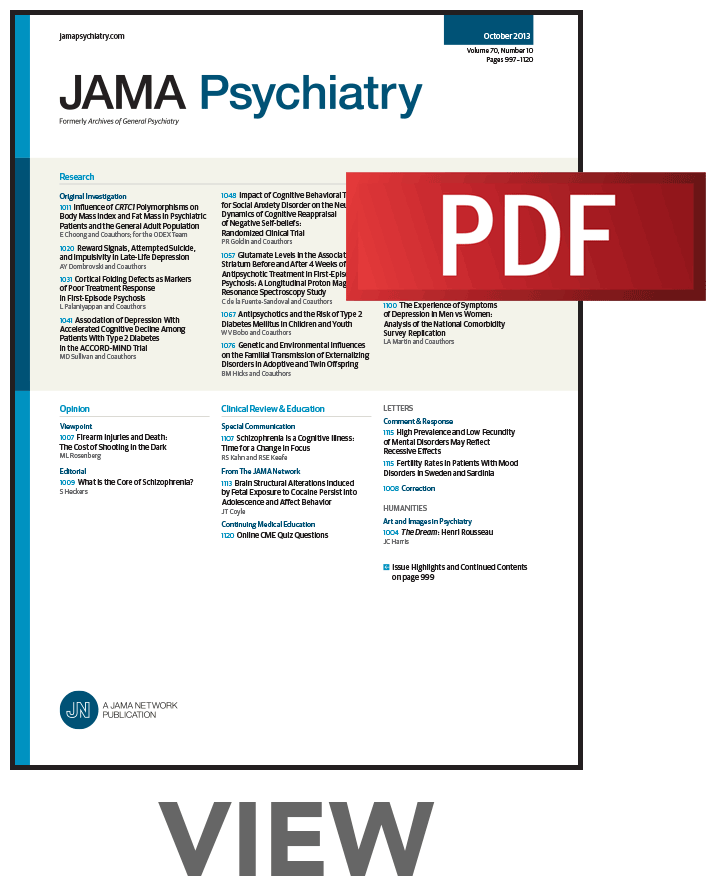精神病诊断中精神病理症状和临床特征的优先排序
IF 22.5
1区 医学
Q1 PSYCHIATRY
引用次数: 0
摘要
重要性精神病学主要研究由大脑功能介导但并非直接归因于特定大脑异常的病症。由于缺乏具体的生物标记,如实验室检测或成像结果,因此诊断系统的开发十分困难。DSM 和《国际疾病分类》(ICD)的有效性有限。研究领域标准是一个研究框架,而非诊断系统。定量得出的精神病理学分层分类法的临床实用性值得怀疑。心理动力学诊断手册第二版》遵循精神分析理论,侧重于人格。与 ICD-11 中的人格评估或 DSM-5 的替代模型(基于五大特质(外向性、合意性、开放性、自觉性和神经质)的病态极端)不同,它缺乏实证依据。网络分析方法令人感兴趣,但其复杂性使其难以实施。如果有可以单独预测的生物标志物,分期会更容易。所有这些新方法的问题在于,它们将患者的经历抽象为更高阶的建构,有可能使个体症状变得模糊不清,以至于它们不再反映患者的实际问题。结论与相关性精神疾病和 DSM 诊断可以被质疑,但幻觉、抑郁、焦虑、强迫等精神病理症状的真实性以及由此产生的痛苦却不能被质疑。因此,也许应该主要根据患者表现出的精神病理症状以及由此产生的个人综合征来描述患者,并将其嵌入包括人格评估和分期在内的临床特征描述框架中。DSM 和 ICD 是报销所必需的,但应加以简化和合并。主要以精神病理症状为基础的临床特征描述方法将是多维的和临床有用的,因为它将导致以问题为导向的治疗并支持跨诊断研究。这种方法应以普遍使用的精神病理学评估工具和结构化临床特征描述为基础。本文章由计算机程序翻译,如有差异,请以英文原文为准。
Prioritization of Psychopathological Symptoms and Clinical Characterization in Psychiatric Diagnoses
ImportancePsychiatry mainly deals with conditions that are mediated by brain function but are not directly attributable to specific brain abnormalities. Given the lack of concrete biological markers, such as laboratory tests or imaging results, the development of diagnostic systems is difficult.ObservationsThis narrative review evaluated 9 diagnostic approaches. The validity of the DSM and the International Classification of Disorders (ICD ) is limited. The Research Domain Criteria is a research framework, not a diagnostic system. The clinical utility of the quantitatively derived, dimensional Hierarchical Taxonomy of Psychopathology is questionable. The Psychodynamic Diagnostic Manual Version 2 follows psychoanalytic theory and focuses on personality. Unlike the personality assessments in ICD-11 or DSM-5 ’s alternative model, based on pathological extremes of the big 5 traits (extraversion, agreeableness, openness, conscientiousness, and neuroticism), it lacks foundation in empirical evidence. Network analytic approaches are intriguing, but their complexity makes them difficult to implement. Staging would be easier if individually predictive biological markers were available. The problem with all these new approaches is that they abstract patient experiences into higher-order constructs, potentially obscuring individual symptoms so much that they no longer reflect patients’ actual problems.Conclusions and RelevanceICD and DSM diagnoses can be questioned, but the reality of psychopathological symptoms, such as hallucinations, depression, anxiety, compulsions, and the suffering stemming from them, cannot. Therefore, it may be advisable to primarily describe patients according to the psychopathological symptoms they present, and any resulting personal syndromes, embedded in a framework of contextual clinical characterization including personality assessment and staging. The DSM and ICD are necessary for reimbursement, but they should be simplified and merged. A primarily psychopathological symptoms–based, clinical characterization approach would be multidimensional and clinically useful, because it would lead to problem-oriented treatment and support transdiagnostic research. It should be based on a universally used instrument to assess psychopathology and structured clinical characterization.
求助全文
通过发布文献求助,成功后即可免费获取论文全文。
去求助
来源期刊

JAMA Psychiatry
PSYCHIATRY-
CiteScore
30.60
自引率
1.90%
发文量
233
期刊介绍:
JAMA Psychiatry is a global, peer-reviewed journal catering to clinicians, scholars, and research scientists in psychiatry, mental health, behavioral science, and related fields. The Archives of Neurology & Psychiatry originated in 1919, splitting into two journals in 1959: Archives of Neurology and Archives of General Psychiatry. In 2013, these evolved into JAMA Neurology and JAMA Psychiatry, respectively. JAMA Psychiatry is affiliated with the JAMA Network, a group of peer-reviewed medical and specialty publications.
 求助内容:
求助内容: 应助结果提醒方式:
应助结果提醒方式:


